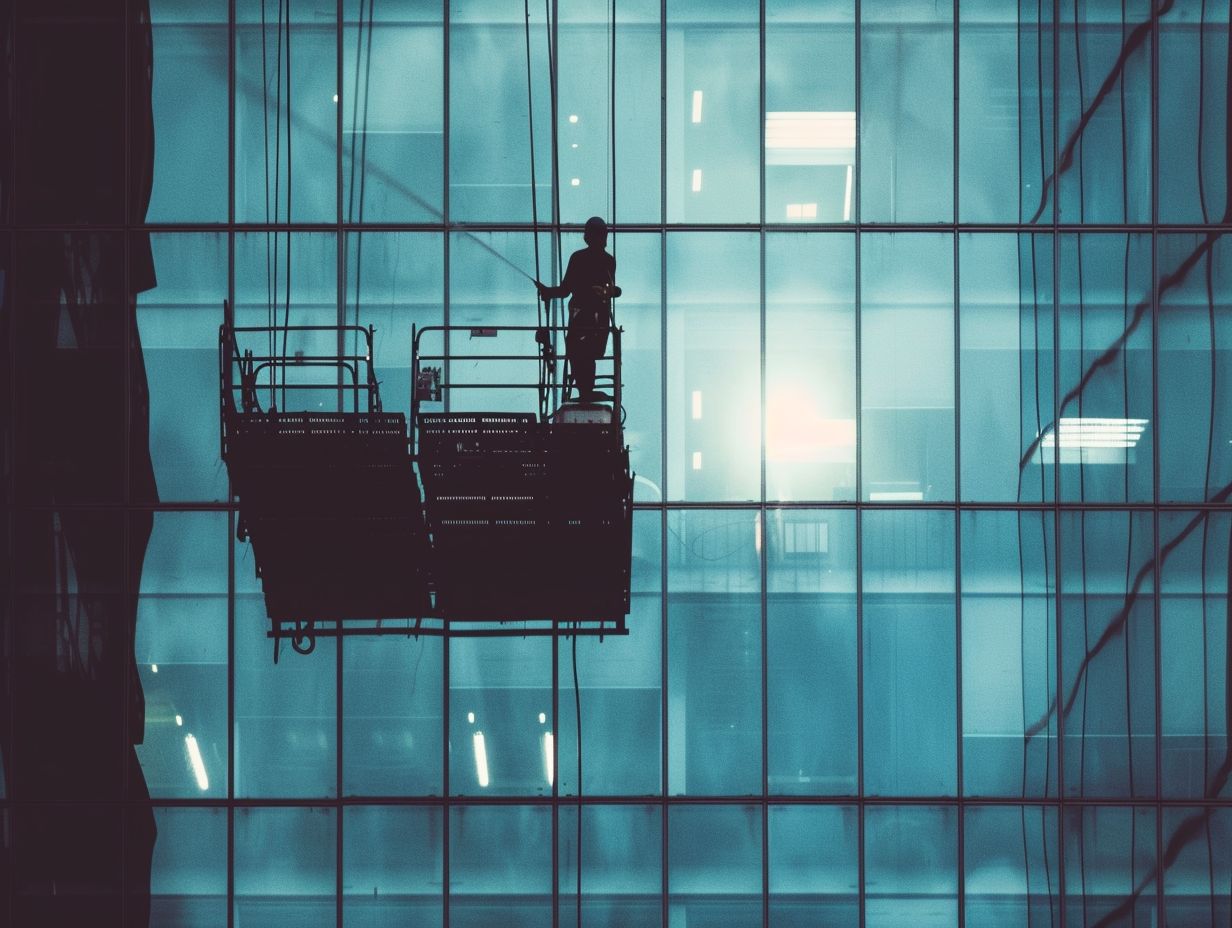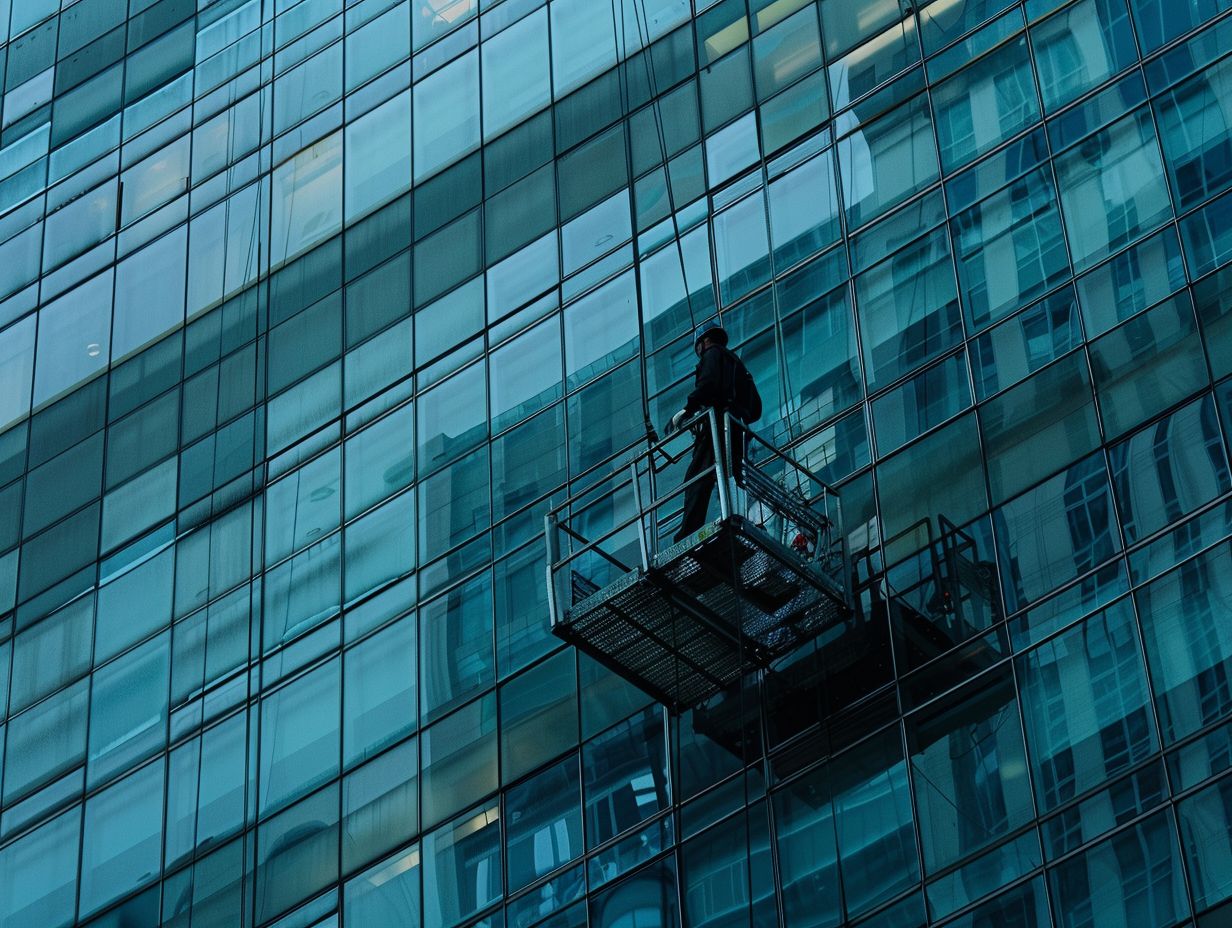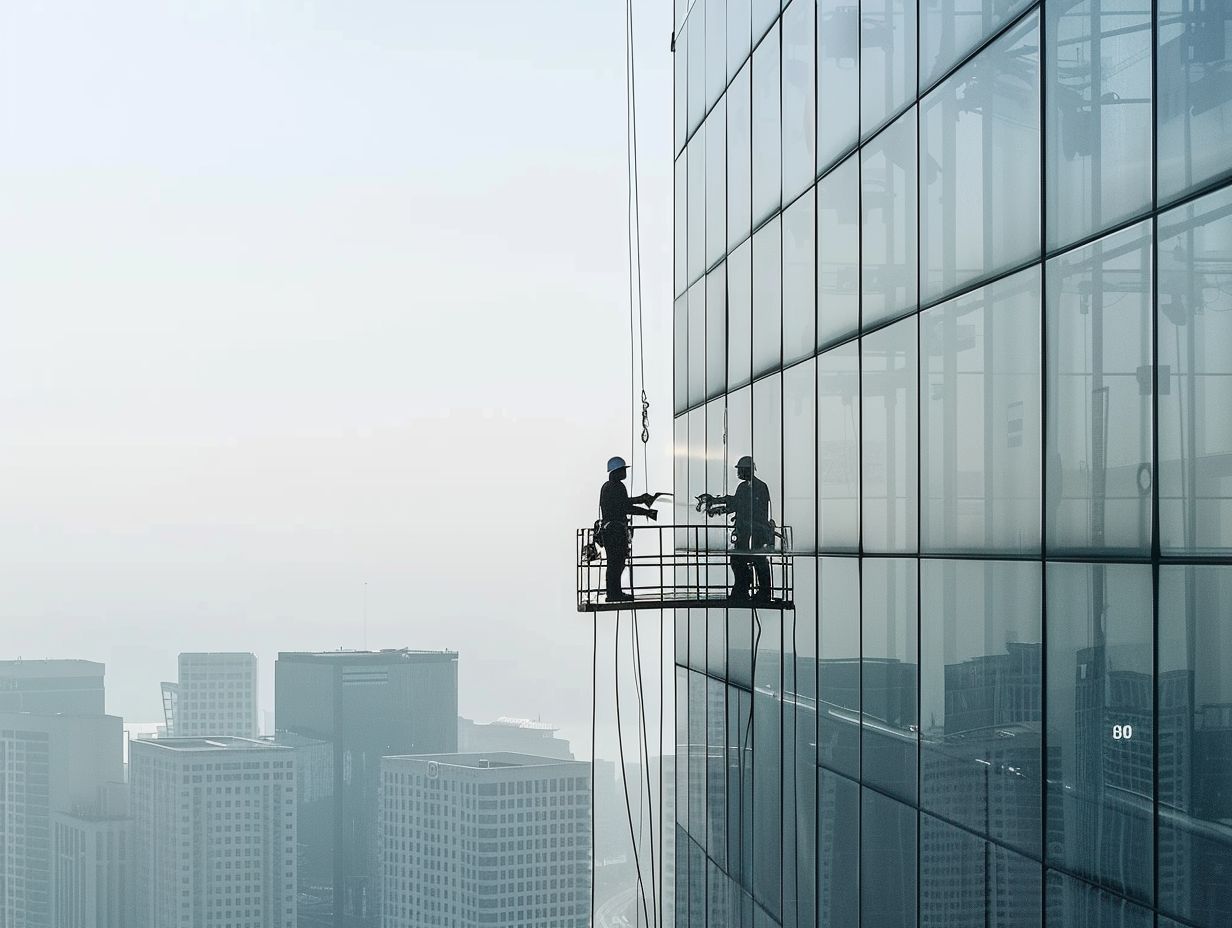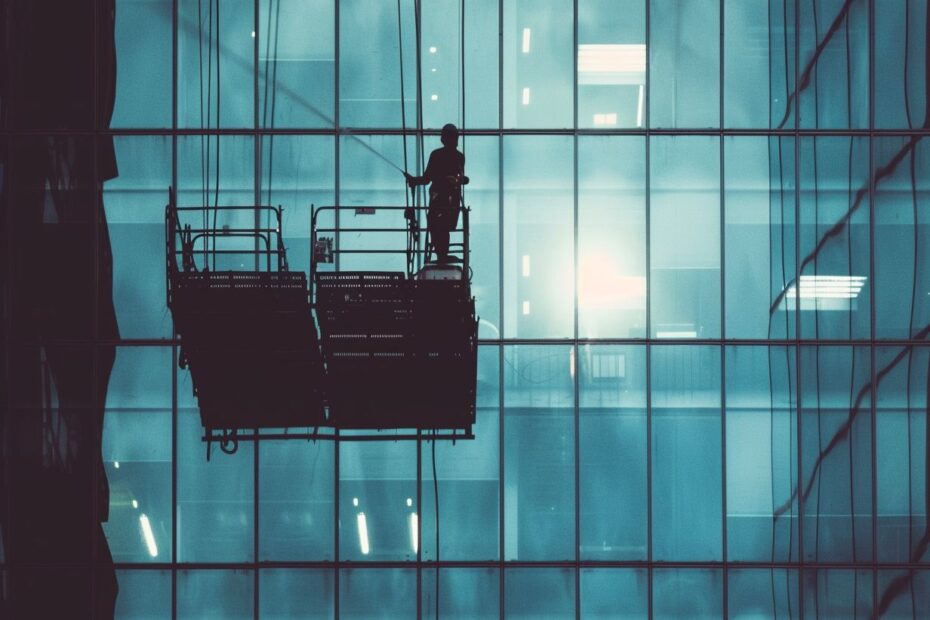Are you curious about the world of high-rise window cleaning?
We delve into the various methods used for this challenging task, such as rope access, aerial lifts, scaffolding, and bosun’s chairs.
We also discuss the importance of safety measures, including training, proper equipment, and weather conditions.
Explore the challenges faced by high-rise window cleaners, such as weather conditions, building design, and safety risks, and gain insights on how these challenges can be overcome.
Stay tuned to learn more about the fascinating world of high-rise window cleaning!
What is High-Rise Window Cleaning?

High-rise window cleaning involves the specialized cleaning of windows on tall structures such as skyscrapers to maintain their aesthetics and structural integrity. This demanding task requires skilled workers and specialized equipment to ensure the safety of personnel while effectively cleaning glass surfaces on commercial buildings and high-rise structures.
One of the primary challenges faced by high-rise window cleaning professionals is the daunting task of working at extreme heights, which requires adherence to stringent safety standards. In addition to the technical aspects of handling cleaning equipment, these workers must also contend with unpredictable weather conditions that can impact their ability to carry out their duties safely. Safety considerations are paramount in this line of work, with workers often using specially designed harnesses and platforms to facilitate the cleaning of facades at dizzying heights, ensuring that each task is accomplished with precision and caution.
What are the Methods for High-Rise Window Cleaning?
High-rise window cleaning employs various methods to access and clean windows efficiently. These methods include rope access, aerial lifts, scaffolding, and the use of Bosun’s Chair. Each technique offers unique advantages based on the building’s structure and height.
-
Rope access, often used in tall structures, involves trained professionals rappelling down the building’s facade using safety harnesses and ropes.
-
Aerial lifts, such as cherry pickers and boom lifts, provide a platform for workers to reach high windows.
-
Scaffolding, a temporary structure erected around the building, allows for efficient cleaning at various levels.
-
Bosun’s Chair, a suspended seat attached to a rope, is ideal for quick and targeted cleaning tasks.
Safety measures, including proper training and equipment inspection, are crucial in high-rise window cleaning to ensure the well-being of workers.
Rope Access
Rope access is a common method in high-rise window cleaning, involving skilled industrial climbers descending from the building’s roof using ropes and harnesses. This technique requires specialized equipment and expertise to ensure the safety of workers while cleaning windows at extreme heights.
Industrial climbers undergo rigorous training to handle the challenges of working at such heights, focusing on safety protocols like regular equipment inspections and double-checking harness connections.
Essential equipment includes descenders, ascenders, carabiners, and anchors, carefully selected for reliability in vertical environments.
Prior to the descent, climbers meticulously assess weather conditions and anchor points for stability.
The crucial role of communication between team members during operations cannot be overstated, ensuring a smooth and secure cleaning process for high-rise windows.
Aerial Lifts
Aerial lifts are another method for high-rise window cleaning, allowing workers to access windows at elevated heights using specialized platforms. These lifts provide a safe and efficient way to clean windows on tall buildings while adhering to strict safety standards.
Equipped with features like sturdy guardrails, emergency descent systems, and interlocks for stability, aerial lifts ensure the safety of workers working at significant heights. Regular maintenance of the equipment is essential to avoid malfunctions during operations, reducing the risk of accidents. By providing a stable and secure platform for cleaning tasks, these lifts enhance productivity and precision for workers in the challenging task of high-rise window cleaning.
Scaffolding
Scaffolding is a traditional method for high-rise window cleaning, providing a stable platform for workers to access and clean windows at various heights. This technique requires proper rigging and safety measures to ensure the workers’ security during overhead work.
Safety is paramount in high-rise window cleaning operations, where workers must adhere to strict guidelines to prevent accidents. Rigging procedures involve securing the scaffolding to the building structure, using sturdy clamps and anchors to withstand the weight and ensure stability. Equipment setup plays a crucial role, with workers wearing harnesses and safety helmets while also using safety nets as a precautionary measure. Regular inspections of the scaffolding and safety gear are essential to mitigate any potential risks associated with working at great heights.
Bosun’s Chair
Bosun’s Chair is a simple yet effective method for high-rise window cleaning, where workers are suspended in a chair-like platform to access and clean windows. This method requires proper fall protection and safety gear to prevent accidents while working at height.
Safety features in Bosun’s Chair play a critical role in ensuring worker security. Harnesses are used to secure workers to the chair, preventing any risk of falling. The fall protection measures integrated into the chair provide an added layer of safety by minimizing the potential impact of a fall.
Proper training on how to use the equipment is essential for workers to understand the importance of following safety protocols when operating at heights. These precautions are vital in mitigating risks associated with high-rise window cleaning.
What Are The Safety Measures for High-Rise Window Cleaning?
Safety is paramount in high-rise window cleaning to protect workers from occupational hazards associated with working at heights. Adequate training, adherence to regulations, and the use of proper safety equipment are crucial for minimizing risks and ensuring a safe working environment.
Training plays a vital role in equipping workers with the necessary skills and knowledge to navigate the challenges of high-rise window cleaning effectively. By undergoing thorough training sessions, workers can learn how to handle equipment correctly, understand safety protocols, and identify potential risks. Regulatory compliance ensures that all safety standards and guidelines are met, reducing the likelihood of accidents and injuries. Addressing occupational hazards proactively not only safeguards workers’ well-being but also enhances overall productivity in window cleaning operations.
Training and Certification

Training and certification play a crucial role in high-rise window cleaning to ensure workers are proficient in using safety harnesses, understanding occupational safety protocols, and handling cleaning equipment effectively. Proper training enhances worker competence and reduces the risks associated with working at height.
Training programs focus on imparting essential skills such as proper positioning while working at heights, effective communication within a team, and techniques for efficient equipment handling.
Safety practices, including regular equipment inspections, emergency response drills, and adherence to industry regulations, are emphasized to ensure a safe working environment for window cleaning professionals.
Utilizing harnesses correctly, anchoring systems securely, and maintaining a keen eye on weather conditions are key aspects covered in these training courses to mitigate potential hazards and ensure a successful high-rise window cleaning operation.
Proper Equipment and Gear
High-rise window cleaning requires the use of proper equipment and gear, including safety harnesses, suspended platforms, and squeegees, to ensure the safety of workers while adhering to industry safety standards. The right gear is essential for efficient and secure window cleaning at elevated heights.
- Harnesses play a crucial role in keeping workers safe by providing fall protection and preventing accidents while working at great heights. These safety harnesses are typically attached to sturdy anchor points on the building to secure the worker in place.
- Specialized tools such as telescopic poles, water-fed brushes, and detailing cloths are commonly used to achieve streak-free and spotless results on high-rise windows.
- Adhering to strict safety standards not only protects workers but also ensures smooth operations and high-quality service delivery to clients.
Weather Conditions
Weather conditions pose a significant challenge in high-rise window cleaning, requiring heightened precautions to ensure worker safety. Wind, rain, or extreme temperatures can impact cleaning operations, emphasizing the need for careful planning and adherence to safety protocols.
In windy conditions, the risk of workers losing their balance or tools being blown away increases, making it crucial to secure equipment properly. Rain can create slippery surfaces, adding another layer of difficulty in maintaining stability while working at height. Extreme temperatures, whether too hot or too cold, can also affect the effectiveness of cleaning solutions and equipment performance.
It is essential for window cleaning companies to stay informed about the weather forecast and make proactive decisions to protect their workers and maintain the quality of their services.
Communication and Emergency Protocols
Effective communication and well-defined emergency protocols are essential in high-rise window cleaning operations to ensure quick responses to potential safety incidents. Clear communication channels and emergency plans help mitigate risks and protect workers in challenging situations.
By maintaining open lines of communication between workers, supervisors, and support teams, it becomes easier to address any safety concerns promptly. In high-risk environments, the ability to relay vital information efficiently can mean the difference between a controlled situation and a potential catastrophe.
Having thorough emergency response plans in place ensures that everyone knows their role and procedures to follow in case of an emergency. Coordination among team members is crucial for effective execution of these protocols, ultimately enhancing overall worker safety on the job.
What Are The Challenges of High-Rise Window Cleaning?
High-rise window cleaning presents various challenges due to factors such as adverse weather conditions, complex building designs, time constraints, and inherent safety risks associated with working at extreme heights. Overcoming these challenges requires meticulous planning, specialized equipment, and adherence to stringent safety measures.
Weather fluctuations can pose a considerable obstacle for window cleaners, leading to cancellations or delays in operations. The intricate structures of high-rise buildings demand advanced techniques and skilled practitioners to ensure thorough cleaning. Safety risks, like precarious working conditions and potential falls, constantly loom over the workers, necessitating strict protocols and protective gear. The limited timeframe for completing tasks adds pressure and necessitates efficient execution to meet deadlines without compromising quality.
Weather Conditions
Weather conditions pose a significant challenge in high-rise window cleaning, affecting worker safety and operational efficiency. Adverse weather, such as strong winds or rain, can create cleaning challenges and necessitate additional safety measures to protect workers from hazards.
In high-rise window cleaning, exposure to extreme weather conditions heightens the risk of accidents and poses obstacles for maintaining pristine windows. High winds can make it challenging for workers to stabilize themselves, while rain can leave streaks and water spots on glass surfaces, hampering the overall cleaning process.
To combat these weather-related obstacles, window cleaning companies implement strict safety protocols, including the use of harnesses, safety ropes, and specialized equipment designed to withstand adverse weather conditions, ensuring that workers can perform their duties effectively while staying safe.
Building Design and Accessibility
The unique design and accessibility of high-rise buildings present challenges for window cleaning professionals. Complex architecture, irregular surfaces, and limited access points require innovative methods and specialized tools to overcome obstacles and ensure thorough cleaning.
With the increasing trend towards constructing skyscrapers with intricate facades and large windows, maintaining cleanliness poses a significant hurdle. The height of these buildings makes traditional cleaning techniques impractical, necessitating the development of new strategies for efficient cleaning. Building design plays a crucial role in the accessibility of windows, and professionals must adapt their approach to navigate the complexities of such structures effectively. Overcoming these challenges requires a blend of expertise, creativity, and the utilization of cutting-edge equipment tailored to high-rise environments.
Time Constraints

Time constraints pose a significant challenge in high-rise window cleaning projects, requiring efficient cleaning methods and meticulous planning to meet deadlines. Regular maintenance schedules and streamlined cleaning procedures are crucial for ensuring timely completion of cleaning tasks on tall structures.
Efficiency is key when it comes to combating these time constraints, as utilizing the best tools and techniques can significantly speed up the cleaning process. Adhering to a strict maintenance schedule helps in preventing the buildup of stubborn dirt and grime, making the cleaning tasks more manageable and less time-consuming. By implementing streamlined procedures, such as dividing the cleaning process into strategic steps and utilizing specialized equipment, window cleaning operations can be optimized for maximum efficiency and effectiveness, ultimately leading to timely completion of projects.
Safety Risks
Safety risks are inherent in high-rise window cleaning due to the elevated work environment and occupational hazards involved. Conducting thorough risk assessments, prioritizing health and safety protocols, and implementing stringent safety measures are essential to mitigate potential risks and ensure worker well-being.
By evaluating the specific challenges of each high-rise cleaning project, such as building height, access points, and weather conditions, professionals can identify potential risks and develop appropriate safety strategies.
Health and safety practices must be strictly adhered to, including the proper use of personal protective equipment and adherence to industry standards. Regular training and supervision play crucial roles in maintaining a safe work environment and preventing accidents.
To safeguard workers from falls and other dangers, it is crucial to invest in reliable equipment and harnesses, conduct regular equipment inspections, and follow established safety protocols.
How Can These Challenges Be Overcome?
Overcoming the challenges of high-rise window cleaning requires innovative solutions, advanced equipment, proper planning, and continuous training of personnel. By leveraging modern technology, implementing safety protocols, and enhancing worker expertise, these challenges can be effectively addressed.
One key strategy is to invest in advanced equipment such as high-reach water-fed pole systems or robotic cleaning devices, which can improve efficiency and safety. Providing comprehensive training programs for employees on the latest techniques and safety measures is crucial. Regular maintenance of equipment and building infrastructure plays a significant role in ensuring optimal cleaning operations. Embracing innovative methods like using eco-friendly cleaning solutions or incorporating drones for inspections can also enhance the overall efficiency and effectiveness of high-rise window cleaning.
Advanced Equipment and Technology
Utilizing advanced equipment and cutting-edge technology is crucial in overcoming the challenges of high-rise window cleaning. Innovations such as water-fed poles, specialized detergents, and automated cleaning systems enhance efficiency and safety in cleaning operations at elevated heights.
These modern tools and techniques reduce the need for manual labor on tall buildings, minimizing the risks associated with traditional cleaning methods. For instance, the development of robotic window cleaners equipped with sensors and cameras allows for precision cleaning without jeopardizing the safety of workers. The use of aerial drones equipped with cleaning equipment provides access to difficult-to-reach areas, making the entire cleaning process more comprehensive and effective.”
Proper Planning and Communication
Effective planning and communication are essential in overcoming challenges in high-rise window cleaning projects. Clear communication channels, detailed planning procedures, and adherence to safety standards ensure smooth operations and successful completion of cleaning tasks on tall structures.
By establishing clear lines of communication among team members, it becomes easier to coordinate tasks, address any unexpected issues, and ensure everyone’s safety. Meticulous planning plays a crucial role in anticipating potential risks and devising strategies to mitigate them. Safety standards should be strictly followed to protect the workers and the public, emphasizing the importance of regular training and equipping employees with the necessary tools and knowledge.
Prioritizing communication, planning, and safety measures not only enhances the efficiency of high-rise window cleaning projects but also minimizes risks and enhances overall project outcomes.
Regular Maintenance and Inspections
Regular maintenance and inspections are key components in overcoming challenges related to high-rise window cleaning. By conducting frequent inspections, identifying maintenance needs, and addressing structural integrity issues promptly, cleaning crews can ensure the longevity and safety of building exteriors.
Structural integrity checks play a vital role in this process by evaluating the building’s framework for any signs of wear or damage that could compromise the stability of window cleaning operations.
Adherence to a well-structured maintenance schedule ensures that all cleaning equipment is functioning optimally and prevents sudden breakdowns during crucial tasks.
Inspection protocols further enhance the efficiency of maintenance efforts by providing a systematic approach to evaluating the condition of windows, frames, and surrounding structures for any potential risks or deterioration.”
Training and Education
Continuous training and education are essential elements in overcoming challenges in high-rise window cleaning. Providing workers with specialized training programs, highlighting safety procedures, and enhancing their skills ensure a competent workforce capable of handling the complexities of cleaning tasks at extreme heights.
It is crucial for high-rise window cleaning companies to invest in ongoing education for their employees, ensuring they stay updated on the latest techniques, equipment, and safety protocols. Skilled workers armed with proper training are better equipped to navigate the risks associated with working at elevated heights.
By prioritizing education and training, companies can improve efficiency, reduce accidents, and maintain high standards of quality in their services. Industry standards demand continuous learning and upskilling to adapt to changing technologies and practices in high-rise window cleaning.
Frequently Asked Questions

What is High-Rise Window Cleaning and why is it important?
High-Rise Window Cleaning is a specialized cleaning service that involves cleaning and maintaining windows in tall buildings or skyscrapers. It is important because it ensures the safety and cleanliness of high-rise buildings, while also maintaining the aesthetic appeal.
What are the different methods used for High-Rise Window Cleaning?
The most common methods used for High-Rise Window Cleaning are rope access, bosun’s chair, scaffolding, and aerial lifts. These methods allow cleaners to safely reach and clean windows on tall buildings.
What are the challenges faced by High-Rise Window Cleaners?
High-Rise Window Cleaning can be a challenging job due to the height, wind, and weather conditions. Cleaners also have to face the risk of equipment failure, lack of proper training, and limited access to certain areas of the building.
How do High-Rise Window Cleaners ensure their safety?
To ensure safety, High-Rise Window Cleaners undergo extensive training and use specialized equipment such as harnesses, safety ropes, and anchorage systems. They also follow strict safety protocols and perform regular equipment checks.
What are the benefits of hiring a professional High-Rise Window Cleaning service?
Hiring a professional High-Rise Window Cleaning service ensures that the job is done efficiently and safely. They have the necessary training, equipment, and experience to tackle the challenges of cleaning tall buildings, while also ensuring the best results.
How often should High-Rise Windows be cleaned?
The frequency of High-Rise Window Cleaning depends on various factors such as the location of the building, weather conditions, and the type of windows. However, it is recommended to have them cleaned at least twice a year to maintain their appearance and prevent damage.




